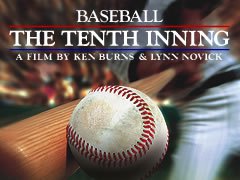
Hall of Famer Rogers Hornsby was once asked what he does all winter. The great 2Bman replied, “I stare out the window and wait for spring.” I am just like Hornsby. No, I don’t have a career 358 BA but I do the same. Unlike most of you, I don’t follow other sports. One tradition I have is viewing Ken Burns’ Baseball to help me survive the endlessly boring winters. A few years back I purchased the “The Tenth Inning,” but hadn’t watched it–until recently.
Hard to believe I was disappointed. True, even a bad Baseball documentary is still good. But this felt more like an ESPN show, not a creation by an award-winning documentarian.
There are several familiar faces that return from the original. Doris Kearns Goodwin, Daniel Okrent, Gerald Early, Thomas Boswell and Bob Costas are back sharing insights. Newcomers include sportswriters Marcus Breton, Howard Bryant, Gary Hoenig, as well as great tales from Keith Olbermann and Mike Barnicle. Chris Rock supplies a few laughs. Bud Selig and Don Fehr are interviewed.
In one of the Special Features both Burns and co-prouder Lynn Novick are interviewed. Burns is a die-hard Red Sox fan, Novick a Yankees fan. Burns stated after his Sox reversed the curse in ’04, he formulated the idea to update the original. And therein lies the problem. This episode covers 1992-2009. However, about 2 ½ of the 4 hours is devoted to only two topics: The Red Sox/Yankee rivalry and steroids.
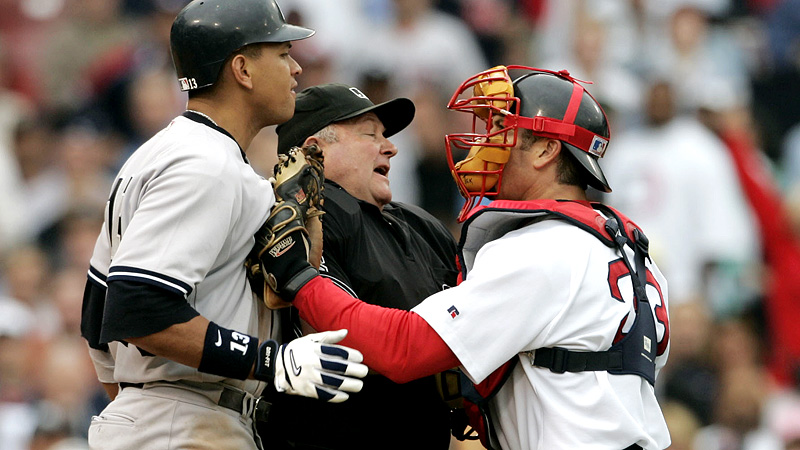
Granted, these were huge topics over the last 20 years. But as a result numerous other subjects and high points were glossed over or ignored completely.
I’m not downplaying the long lasting effects of the Steroid Era. But I felt far too much emphasis was focused on this topic. The steroids issue was presented in such a way I thought I was watching Dateline.
“The Tenth Inning” was little more than a MLB highlight reel. Gone were the personal stories from those in the game. The only ballplayer interviewed was Pedro Martinez. Felipe Alou appeared briefly in addition to Yankee skipper Joe Torre who received approximately 25 minutes of airtime.
The earlier innings were, by and large, centered on the individual player and his significance to the game. Rarely was a section focused on a ‘team.’ Much of The Fourth Inning, A National Heirloom, was centered on Babe Ruth. A good portion of the Sixth Inning, The National Pastime, was focused on Jackie Robinson. This tenth inning, as a result of overkill on two topics, left many important issues not covered.
After 86 years, Boston finally won the World Series and received endless coverage. On the flipside, the White Sox ended their 88 year drought in 2005 but it was not even mentioned.
In 2003, the Cubs were 5 outs away from returning to the Series for the first time since 1945, possibly winning their first Championship in 95 years. Yes, there was poor old Steve Bartman again. But no time was devoted to the long storied history of Cubs futility. A brief recap of their century long slump would have brought into perspective the fan interference call.
The overkill of Yankees/Red Sox and Steroids left much on the cutting room floor.
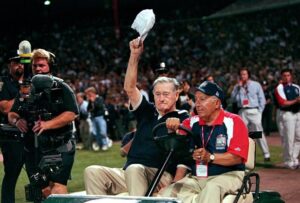
The first 9 innings covered the 20th Century. Yet, one of Baseball’s most glorious moments, the 1999 All-Star Game when yes, The All-Century Team was introduced, was not examined. Ted Williams at Fenway. How much better does it get?
The influx of Latin players received a good amount of air-time. Yet, there was no mention of the decline and almost complete disappearance of African-Americans from the field. I found this interesting, especially since, and rightfully so, so much focus throughout the original was paid to Jackie Robinson’s arrival, the fading away of the Negro Leagues and the horrors that black ballplayers such as Hank Aaron and Curt Flood endured decades after the end of The Gentleman’s Agreement.
Two of the most popular broadcasters in history, Jack Buck and Harry Caray, adored by generations of fans in Chicago and St. Louis, died in 2002 and 1998 respectively. Yet, they were omitted. There was nothing said about Baseball returning to the nation’s capital after almost forty years. Nor was the addition of teams in Tampa Bay, Colorado, Miami or Arizona discussed. The D-backs only got mentioned when Burns turned his focus to the 2001 Yankees.
As the bulk of the 4 hours centered on the big market Yankees and Sox, the fact that small market clubs on a shoestring budget, such as Oakland, Minnesota, Tampa Bay and Miami remained competitive, was again barely discussed. The Twins, Rays and Marlins with their 2 titles received no air-time.
With the exceptions of the Braves dominant Big Three and the high profile trio of McGwire, Sosa and Bonds, many other great players from the last 20+ years were non-existent.
Ken Griffey Jr, one of the most loved players of his generation appeared on the cover of the DVD but only was briefly mentioned in the opening minutes. Admired Kirby Puckett, who retired early due to injuries, became one of the youngest players enshrined in Cooperstown and tragically died at 45 years old, was absent. Tony Gwynn’s 338 career BA may have been the highest of the last half-century but apparently that wasn’t worthy of being highlighted. One glaring and unbelievable lapse relates to the greatest lead-off hitter ever. Rickey Henderson is the all-time leader in SB’s (1406), runs, (2295), lead-off HR’s (81) and unintentional walks (2129.) He was rarely out on the bases but he was out of The Tenth Inning.
How can you discuss the last 20 years without including Trevor Hoffman, Robby Alomar, Jim Thome, Albert Pujols, Miguel Cabrera, Chipper Jones, Craig Biggio and the man who hit more HR’s than any other catcher in history, our own Mike Piazza.
When Aaron Boone, Scott Brosius and Kevin Millar get more attention than Pujols, Cabrera and Alomar, somethin’ aint right.
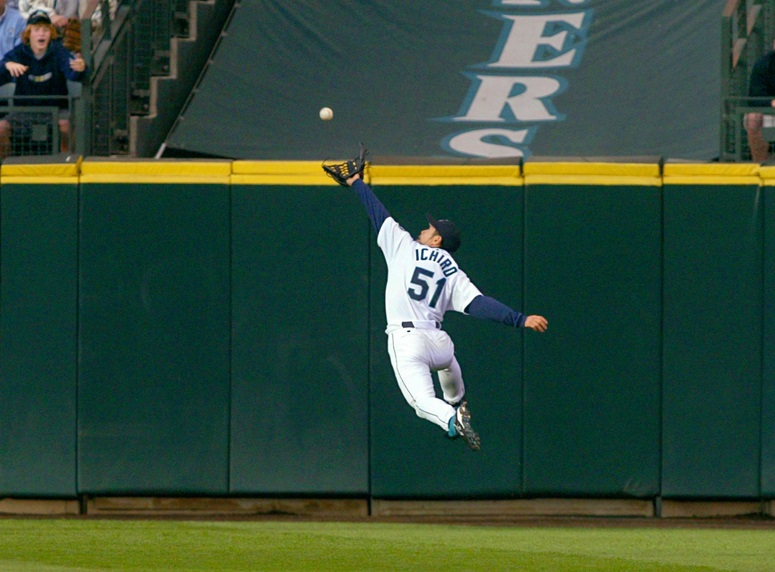
One part of The Tenth Inning was almost laughable. Burns and Novick highlighted the arrival of Ichiro Suzuki, the first Japanese position player. It underscored the fact that in the midst of balls flying out of ballparks, a slap hitter won the admiration of fans coast to coast. They made mention of his All-Star game appearances, numerous Gold Gloves and Batting titles. However, while praising Ichiro, they completely failed to include the fact he set the record for most hits in a season (262), a mark that had stood for 84 seasons. To discuss Ichiro without acknowledging his crowning achievement was a monumental blunder.
As for our beloved Mets? Well, let’s be honest. The period 1992-2009 wasn’t a great run for us. However, we were ignored entirely. In the Seventh Inning, The Capital of Baseball (1950-1959), that entire episode centered on New York’s dominance and that seemingly every October there was a Subway Series. Yet, in 2000, when the first Subway Series occurred in four and a half decades, this too was omitted.
Being a New Yorker and Mets fan I was greatly disturbed about the way 9/11 was portrayed. After the Towers were shown on fire and crumbling, the next baseball scene was the Yankees playing the White Sox with Chicagoans holding ‘We Love New York’ signs. There was no mention of the first post-9/11 game in New York, which happened at Shea and not even a mention of Piazza’s HR that healed a city. To add insult to injury, in one of the special features, Joe Torre was talking about how he and some of his players visited families of numerous victims. I’m not playing one-upmanship with regards to a horrific event. But I found it slightly appalling that a filmmaker with the credentials of Ken Burns would emphasize the role of one NY team while completely ignoring the other. A casual fan would think the Mets went the way of the Washington Senators after 1986.
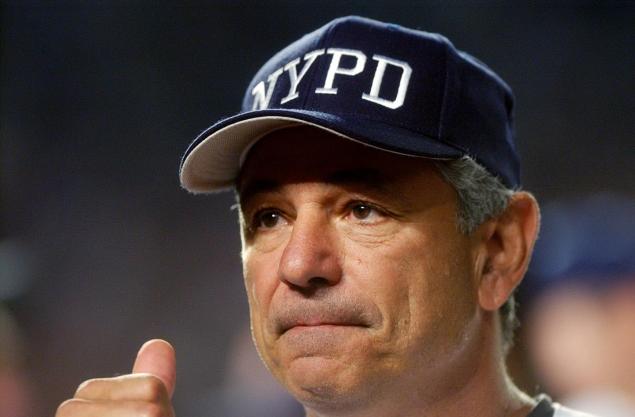
To illustrate the above point, one part focused on how the game got away from the cookie-cutter stadiums of the 60’s and 70’s and built new parks with a retro field. 19 of 30 teams built new homes starting in 1990. If you recall the original documentary, much emphasis was placed on the lore and homey feeling of Ebbets Field. Yet, when the Mets build a retro stadium with an exterior that replicates the Dodgers home, that too, is avoided.
Interestingly, one problem the game has faced over the last generation is the widening gap between big markets and small markets. Yet, Mr. Burns perpetuated that in ‘The Tenth Inning’ by focusing on Boston and New York while largely ignoring everyone else.
